

Paper project. Carl Jung. Carl Gustav Jung (/jʊŋ/; German: [ˈkarl ˈɡʊstaf jʊŋ]; 26 July 1875 – 6 June 1961), often referred to as C.

G. Jung, was a Swiss psychiatrist and psychotherapist who founded analytical psychology.[2] Jung proposed and developed the concepts of the collective unconscious, archetypes, and extraversion and introversion. His work has been influential not only in psychiatry but also in philosophy, anthropology, archeology, literature, and religious studies. He was a prolific writer, though many of his works were not published until after his death. The central concept of analytical psychology is individuation—the psychological process of integrating the opposites, including the conscious with the unconscious, while still maintaining their relative autonomy.[3] Jung considered individuation to be the central process of human development.[4] Early years[edit] Childhood family[edit] Jung's mother left Laufen for several months of hospitalization near Basel for an unknown physical ailment.
Carl Jung Biography. Best Known For: Studies of the human psyche.Dream analysisThe collective unconsciousArchetypes Birth and Death: Carl Jung was born July 26, 1875He died June 6, 1961.
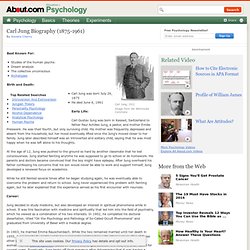
Profile Jane Flax. Adrienne Rich. Welcome to BehaviorWorks.org. Nancy Chodorow. Nancy Chodorow Biography. Anzia Yezierska. Anzia Yezierska (1885 - 1970) was an American novelist born in Maly Plock, Poland.
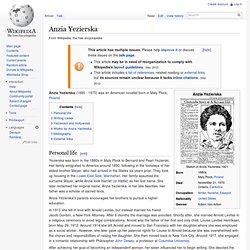
Personal life[edit] Yezierska was born in the 1880s in Maly Plock to Bernard and Pearl Yezierski. Her family emigrated to America around 1890, following in the footsteps of her eldest brother Meyer, who had arrived in the States six years prior. They took up housing in the Lower East Side, Manhattan. Her family assumed the surname Mayer, while Anzia took Harriet (or Hattie) as her first name. Anzia Yezierska's parents encouraged her brothers to pursue a higher education. Lies Her Mother Told Us: Louise Levitas Henriksen's Critique of Anzia Yezierska's Autobiography.
The Bad Mother Manifesto. There is a spectre haunting the parenting community – the spectre of the Bad Mother…* My name is Catherine, and I am a bad mother.
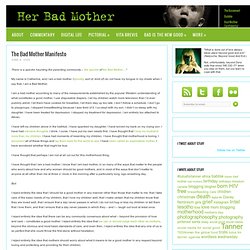
I (mostly, sort of, kind of) do not have my tongue in my cheek when I say that. I am a Bad Mother. I am a bad mother according to many of the measurements established by the popular Western understanding of what constitutes a good mother. I use disposable diapers. I have left my children alone in the bathtub. I have thought that perhaps I am not at all cut out for this motherhood thing.
AMERICAN EUGENICS SOCIETY 1922-1994. Social Origins of Eugenics. Eugenics Popularization Steve Selden, University of Maryland Eugenic ideology was deeply embedded in American popular culture during the 1920s and 1930s.
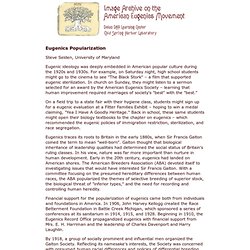
For example, on Saturday night, high school students might go to the cinema to see "The Black Stork" – a film that supported eugenic sterilization. In church on Sunday, they might listen to a sermon selected for an award by the American Eugenics Society – learning that human improvement required marriages of society's "best" with the "best. " On a field trip to a state fair with their hygiene class, students might sign up for a eugenic evaluation at a Fitter Families Exhibit – hoping to win a medal claiming, "Yea I Have A Goodly Heritage. " Eugenics traces its roots to Britain in the early 1880s, when Sir Francis Galton coined the term to mean "well-born".
Financial support for the popularization of eugenics came both from individuals and foundations in America. American Eugenics Society. The American Eugenics Society (AES) was a society established in 1922 to promote eugenics in the United States. It was the result of the Second International Conference on Eugenics (New York, 1921). The founders included Madison Grant, Harry H. Society for the Study of Social Biology. "Human Sterilization," Human Betterment Foundation (5) Home DNA Learning Center Preparing students and families to thrive in the gene age Website Search "Human Sterilization," Human Betterment Foundation (5)
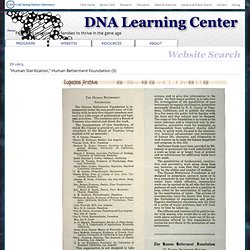
Human Betterment Foundation. 1938 HBF pamphlet titled "Human Sterilization Today".
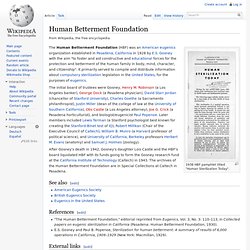
Gattaca, 1997 - Deleted Clinic Scene, post-screening genetic manipulation.m4v. Bread Givers. Bread Givers is a 1925 novel by Anzia Yezierska describing the story of a girl growing up in a household run by immigrant parents originally from Poland.
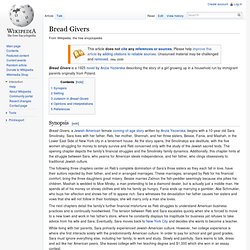
Synopsis[edit] Bread Givers, a Jewish-American female coming-of-age story written by Anzia Yezierska, begins with a 10-year old Sara Smolinsky. Sara lives with her father, Reb, her mother, Shennah, and her three sisters, Bessie, Fania, and Mashah, in the Lower East Side of New York city in a tenement house. As the story opens, the Smolinskys are destitute, with the five women struggling for money to simply survive and Reb concerned only with the study of the Jewish sacred texts. The opening chapter depicts the family's financial struggles and the Smolinsky family dynamics. The following three chapters center on Reb's complete domination of Sara's three sisters as they each fall in love, have their suitors rejected by their father, and end in arranged marriages.
Mrs. Setting[edit] How I Found America: Collected Stories: Anzia Yezierska, Vivian Gornick: 9780892552986: Amazon.com. Hungry Hearts. [Title Page] BOSTON AND NEW YORK HOUGHTON MIFFLIN COMPANY The Riverside Press Cambridge 1920 The Riverside Press CAMBRIDGE .
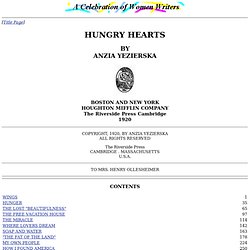
MASSACHUSETTS U.S.A. How to be a Jewish Mother (revised): Dan Greenburg: 9780843133691: Amazon.com. Portnoy's Complaint: Philip Roth: 9780679756453: Amazon.com. Battle Hymn of the Tiger Mother: Amy Chua: 9781594202841: Amazon.com. Generation of Vipers: Philip Wylie: 9781564781468: Amazon.com. The Myth of Women's Masochism: with a new preface by the author: Paula J. Caplan: 9780595357505: Amazon.com.